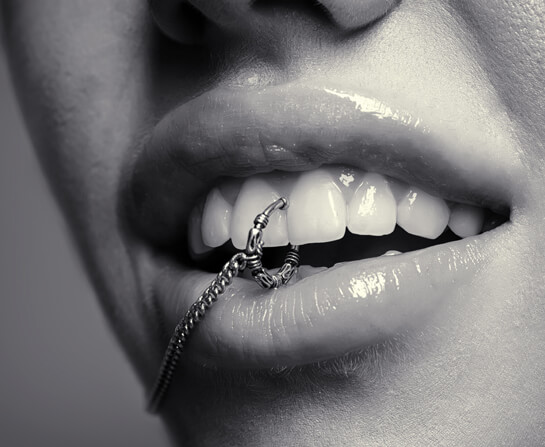Oral Piercing: A New Fad in Body Piercing
April 25, 2022 Return

WORDS DR ANDREW CHAN KIENG HOCK
Consultant Oral Surgeon
Private Dental Practice Klang, Selangor.
Body piercing, including oral piercing, is a form of body art or self-expression with similarities to body tattooing. By definition, body piercing is the practice of puncturing or cutting a part of the human body, in which jewelry or implants can then be inserted. They are often physically visible but sometimes hidden, such as in the case of charm needles (susuk), which are embedded subdermally on the face. In this article, Dr Andrew Chan Kieng Hock discusses some of the more common side- effects due directly to oral piercings and steps that can be taken to minimize them.
The History of Body Piercing
Ample historical records indicated that this practice has been common since ancient times and is practiced by both sexes. The hardware can be metallic or non-metallic objects such as stainless steel, niobium, titanium, gold alloy, silver, bone, ivory, stone, horn or even synthetic materials like PMMA (polymethyl methacrylate) and PTFE (polytetrafluoroethylene).
The reasons for practicing body piercing are numerous. They include religious or spiritual aspects; to conform to a certain popular or tribal culture; for aesthetic value or body adornment; self-expression in making a fashion statement; eccentric lifestyle choices, and even for sexual pleasure.
The most common sites for body piercing are the ear lobes and the noses. Even though in this age of modernity the practice is rampant, some countries—including several states in the US as well as certain European countries—prohibit or ban such practices until the person is at least 16 or 18 years of age; otherwise, parental consent is required. Most state schools, churches, or corporate companies do not allow their members to openly exhibit or display their body piercings due to dress code violation.
Contrary to popular belief, any form of piercing including in the oral cavity is an invasive and risky surgical procedure. Dentists are seeing more and more cases of oral piercings which went wrong, resulting in serious complications.
As far as oral healthcare providers are concerned, oral piercings irrespective of site or materials are not harmless but often come with some side-effects, which most owners are ignorant about. These complications, which have been reported in scientific journals as well as personally encountered by practicing dentists, include:
- Speech, swallowing, and chewing impairment
- Tooth fracture and chipping as well as damage to fillings and dental prosthetics due to the knocking effect from the jewelry
- Gingival trauma and recession
- Profuse bleeding especially in the tongue region as the organ is highly vascularized (blood vessels)
- Pain
- Loss of taste
- Risk of blood-borne infections such as HIV, hepatitis B and C, and tetanus due to contaminated equipment
- Increased salivary flow resulting in uncontrolled drooling
- Numbness due to nerve damage
- Infection at the pierced site which in rare cases can lead to septicaemia and bacteria endocarditis. This is because the mouth is home to numerous microorganisms
- Swelling which can compromise or obstruct the airway
- Interference when taking X-ray
- Foreign body reaction leading to keloid scarring
- Allergic reactions to the material especially metal alloy with nickel elements.
What role can a dentist play?
If patients intend to perform oral piercing but have yet to do so, they must be advised against it by explaining all the possible side-effects. Nonetheless, in the event they insist on proceeding with the piercing, they should be advised to get the procedure done by a professional or trained body piercer in a piercing studio, which is kept in a clean and hygienic condition at all times, since it is an invasive and risky surgical procedure. The American Dental Association (ADA) lists very helpful guidelines to patients who have existing oral piercings.
List of guidelines from the American Dental Association (ADA) regarding oral piercings:
- Contact a dentist or physician immediately if there are any signs of infection such as swelling, pain, fever, chills, shaking, or a red- streaked appearance around the site of the piercing.
- Keep the piercing site clean and free of any matter that may collect on the jewelry by using a mouth rinse after every meal.
- Try to avoid clicking the jewelry against teeth and avoid putting pressure on the piercing.
- Be gentle and aware of the jewelry’s movement when talking and chewing.
- Check the tightness of the jewelry periodically with clean hands. This can help prevent from swallowing or choking if the jewelry becomes dislodged.
- When taking part in sports, remove the jewelry and protect the mouth with a mouthguard.
- See a dentist regularly and remember to brush twice a day and floss daily.
Dentists need to stress to owners of piercings that they need to maintain good oral hygiene and keep up with their dental check-ups regularly. Oral piercings seem to be on an increasing trend as dentists encounter not only more but also younger patients with various forms of oral piercings. This type of body art is associated with real complications, which dentists should themselves be familiar with, so that they in turn can educate patients professionally and appropriately on this issue.
If you like this article, do subscribe here.
References:
1. ADA. Guidelines on oral piercing. Retrieved from https://www.ada.org/en/member-center/oral-health-topics/oral- piercing.
2. Levin, L., et al. (2005). Oral and dental complications of intra-oral piercing. Dent Traumatol.;21(6):341–343. 3. De Moor, R.J., et al. (2005). Dental and oral complications of lip and tongue piercings. Br Dent J.;199(8):506–509.
